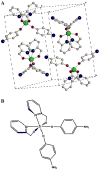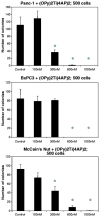Cytotoxic activity of the titanium alkoxide (OPy)(2)Ti(4AP)(2) against cancer colony forming cells
- PMID: 20820908
- PMCID: PMC3977178
- DOI: 10.1007/s10637-010-9530-3
Cytotoxic activity of the titanium alkoxide (OPy)(2)Ti(4AP)(2) against cancer colony forming cells
Abstract
A novel family of titanium alkoxides with two stable pyridinemethoxide moieties bound to a titanium metal center were synthesized and tested for cytotoxic activity on a variety of cancer cell lines using colony formation assays. One compound, (OPy)(2)Ti(4AP)(2), where OPy is NC(5)H(5)CH(2)O(-), and 4AP is 4-aminophenoxide ((-)OC(6)H(5)(NH(2))-4), demonstrated increased cytotoxicity in breast, colon, and pancreatic cancer cell lines at 100 nanomolar levels with only short exposures. Further, (OPy)(2)Ti(4AP)(2) had activity in colon and pancreatic cancer cell lines that are usually resistant to chemotherapy. This demonstrates that these titanium compounds may have a role in anti-cancer therapy, similar to platinum-based compounds, and the (OPy)(2)Ti(4AP)(2) compound specifically deserves further investigation as an anti-cancer agent in chemo-resistant solid tumors.
Figures




Similar articles
-
A Comprehensive Review on the Development of Titanium Complexes as Cytotoxic Agents.Curr Top Med Chem. 2024;24(24):2117-2128. doi: 10.2174/0115680266317770240718080512. Curr Top Med Chem. 2024. PMID: 39108106 Review.
-
On the Cytotoxicity of Chiral Ruthenium Complexes Containing Sulfur Amino Acids against Breast Tumor Cells (MDA-231 and MCF-7).Anticancer Agents Med Chem. 2021;21(9):1172-1182. doi: 10.2174/1871520620666200824114816. Anticancer Agents Med Chem. 2021. PMID: 32838726
-
Cytotoxic salan-titanium(IV) complexes: high activity toward a range of sensitive and drug-resistant cell lines, and mechanistic insights.ChemMedChem. 2012 Apr;7(4):703-8. doi: 10.1002/cmdc.201100593. Epub 2012 Jan 20. ChemMedChem. 2012. PMID: 22262543
-
Improving Cytotoxicity against Breast Cancer Cells by Using Mixed-Ligand Ruthenium(II) Complexes of 2,2'-Bipyridine, Amino Acid, and Nitric Oxide Derivatives as Potential Anticancer Agents.Anticancer Agents Med Chem. 2021;21(12):1602-1611. doi: 10.2174/0929867327666201020155105. Anticancer Agents Med Chem. 2021. PMID: 33081686
-
Metal complexes against breast cancer stem cells.Dalton Trans. 2021 Oct 26;50(41):14498-14512. doi: 10.1039/d1dt02909f. Dalton Trans. 2021. PMID: 34591055 Review.
Cited by
-
Synthesis, spectral characterization, and antiproliferative studies of mixed ligand titanium complexes of adamantylamine.Bioinorg Chem Appl. 2014;2014:142828. doi: 10.1155/2014/142828. Epub 2014 Feb 27. Bioinorg Chem Appl. 2014. PMID: 24715822 Free PMC article.
-
A Comprehensive Review on the Development of Titanium Complexes as Cytotoxic Agents.Curr Top Med Chem. 2024;24(24):2117-2128. doi: 10.2174/0115680266317770240718080512. Curr Top Med Chem. 2024. PMID: 39108106 Review.
References
-
- Wohl D, Canetta R. Clinical development of platinum complexes in cancer therapy: an historical perspective and an update. Eur J Cancer. 1998;34:1522–1534. - PubMed
-
- Desoize B, Madoulet C. Particular aspects of platinum compounds used at present in cancer treatment. Crit Rev Oncol Hematol. 2002;42:317–325. - PubMed
-
- Kelland L. The resurgence of platinum-based cancer chemotherapy. Clin Cancer Res. 2007;13:4960–4963. - PubMed
-
- Caruso F, Rossi M. Antitumor titanium compounds. Mini Rev Med Chem. 2004;4:49–60. - PubMed
-
- Harding MM, Mokdsi G. Antitumour metallocenes: structure-activity studies and interactions with biomolecules. Curr Med Chem. 2000;7:1289–1303. - PubMed
Publication types
MeSH terms
Substances
Grants and funding
LinkOut - more resources
Full Text Sources
Medical

